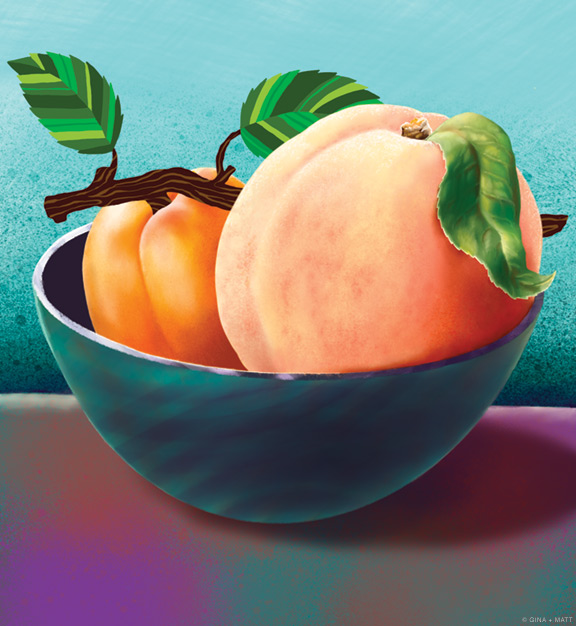
“The back-lit, bright green canopies were gilded, too—with bright orange balls.”
By Cynthia McVay
Some years ago, after spending a few days in Istanbul, a friend and I drove into the interior of Turkey. We got out in the town of Göreme, a World Heritage Site in Cappadocia, one of the most extraordinary places I’ve ever been. One civilization after another has passed through this plateau—Christian, Byzantine, Roman, Turkish, Armenian—settling among and within toothy formations of soft volcanic rock people hollowed out to create surreal dwellings and sites of worship. So it is a realm where civilizations as well as anthropology and geology collide. How does an archaeologist or preservationist, contemplating the dome of one of these fairy drip castles, decide whether to restore the 16th-century frescoes, the 13th-century gilded ceilings a few inches beyond, or third-century Roman drawings that predate them all? What a dilemma!
We slept in an unadorned castle-cave and rose in the morning to trek along the rim of the Ihlara Valley. No one else was there. You’d think it would be jumping with tourists, but we were alone, discovering and savoring one breathtaking, intimate room after another. Inside some of them, gold leaf or paint glittered from dusty walls, lit by sun that filtered through dozens of small round openings that punctured the walls, which from a distance created a visual rhythm in the landscape. These nooks, we learned, were of more recent vintage—carved in the last century by pigeon keepers who occupied the spaces.
When we’d had our cultural fill, we descended into a vast expanse of trees, happy to find shade for our walk across the valley. When we looked up, we saw that the back-lit, bright green canopies were gilded, too—with bright orange balls. We were in an apricot orchard, each branch jam-packed with perfectly ripe Turkish apricots. I freed a soft, blushing one and rolled it in my palm. The warm, velvety, juicy morsel found my mouth. Its flavor was unlike any apricot I’d eaten in the States—bursting with a concentrated intensity that recalled the dried variety. Low on water, we inhaled dozens of succulent apricots as we made our way through the valley to the other side.
Still, there was not a soul in sight. There were no signs posted, no one to ask permission for our walking harvest, or to offer recompense. Just branch after branch bent under the weight of fruits beyond counting. At the time we didn’t feel like trespassers, but appreciators.
This unexpected apricot bounty reminded me of half a dozen stocky white peach trees I had discovered years earlier on my own defunct farm in the Hudson Valley. Perhaps the previous owner had mentioned them, as he did his grandmother’s heirloom rose bush, three pear trees, and the watercress in a stream bed that took me a while to locate. But I think I found those modest white peach trees on my own, dotting the slope behind the lean-to.
These peach trees were in survival mode: gnarly and weather-worn, undoubtedly on their last legs. But when the fruit arrived in August, I parked myself in the shade of the largest tree, reached up and pulled down a large orb. As my teeth punctured the taut skin and bit into its rose-infused flesh, the juice exploded. It was, to this day, the best peach bite I have ever eaten.
But I wasn’t the only one ravaging the peaches. Beetle borers had settled into the trunks and the fruit was covered with black holes and sticky spots where the juice bubbled and gelled. I ate as many peaches as I found, savoring one or two bites per peach while avoiding those scary spots. Is that why they tasted so good, even more precious?
A few seasons later I took down the infested, by-then-unproductive trees before they became poison ivy magnets, so I could get the tractor through. I mourned their loss for years.
The astonishing thing about fruit trees is how much fruit a single tree can generate. Many of the couple dozen apple trees I excavated from poison ivy, pruned, and nursed back to life have toppled over the decades. But the one closest to the house produces so many very organic apples that I eat three or four per day in the fall to keep up. The tree has overwhelmed me for years, yet it still astonishes me anew each season.
Meanwhile, two Bartlett trees drop dozens of pears per day to litter the ground below. If I leave them, they attract bees or are smushed by the lawnmower. The pressure to keep up is immense. But what a problem to have: too many unblemished ripe pears! I poach, dry, freeze, puree, and serve with cheese. I give them away to everyone I bump into. Bags and bags and bags.
When my Labrador Charlotte was still with us, she used to check under the pear trees first thing when we arrived for the weekend. Dexter, my current canine companion, doesn’t eat the pears but dives for the apples on a hot day.
Eating from the land provides immense satisfaction. I anchor the seasons in my daily walks. Foraging in spots I know about and picking from old fruit trees carries an element of comfort along with renewed discovery every year. In the spring, asparagus pushes through the thick grass in the meadow: warm, fresh, exquisite. Fiddlehead ferns and most mushrooms are, of course, toxic when eaten raw, so I look forward to sauteing them with garlic and chili flakes.
In July, taking a walk through the field, I hover on the edge among the blackberry and raspberry thickets. My hands rummage for flawless ripened raspberries releasing from their torus, sometimes too quickly to apprehend. I press the amalgamation of 100 drupelets onto my tongue. Mmmm. I remind myself that blackberries are better cooked, as jam.
I am fortunate to be able to casually graze my land, but the demise of the white peach trees left a void. I must have mentioned them frequently because not so long ago my daughter gave me three one-foot-tall peach saplings.
“You loved your peach trees, right, Mom?”
I planted the small sticks in my garden, near the house, so I could keep an eye on them, and think of my daughter when I see them, which is daily. They have grown a yard a year, and last year, one had more fruit than I could keep up with. They dropped from the tree: small, rock hard, greenish, perhaps prematurely. I gathered them from the garden floor and brushed them off. Sadly, in their raw state they were almost inedible. I was considering fertilizing and pruning them this year to see if there’s a way to sweeten them. But maybe I won’t. After drying, poaching, and stewing them in sugared water, they remind me of those Cappadocia apricots.
And on the off chance that a certain Turkish tree farmer should stumble upon my tiny orchard on a holiday of his own, it would behoove me to have some ready at hand to share.
Cynthia McVay G’88 WG’88 is an artist, writer, and rower based in the Hudson Valley and St. Croix.





Having just experienced some deliciously sweet apricots in Tuscany, I am reminded that I had to leave the Trader Joe apricots on the window sill for over a week just to get them soft! Your farm is special in so many delightful ways!
Love this so much! Deeply evocative and wonderful!
Such luscious description and sentiment about the bounty we share now and with the future.
Yum! What a feast of a story! I could taste and enjoy every seasonal fruit and vegetable the author so sensuously illustrates. Just beautiful!
This delightful piece transported me from Turkey to the Hudson Valley and is dripping with imagery as delicious as the fruit it describes. Brava!